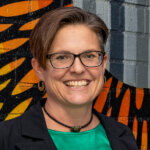Placing people at the heart of our centres

Placing people at the forefront of a project team’s design process can bring vitality, vibrancy, and viability to a shopping centre, especially when the designer has lived experience of the community they are serving.
This lived experience has a depth of understanding and authenticity that comes through as a richness in the knowledge of the patterns and flows of that place and what that place is expressing and needs. According to the UX Collective, an independent design publication, lived experience is a dynamic phenomenon, one which we fully encounter in our intuitive minds, an aspect that many quantitative research methodologies fail to capture.
There is the approach of designing ‘for’ community and then there is the depth of designing ‘with’ community. On Eastern Creek Quarter, we had the opportunity to be designing the ‘with and for’ community with our architect Dino Delotavo leading the charge on working to bring a retail centre full of life to a diverse community where he had lived for many years.
Community engagement can often be a process seen as a quantitative research based tick box exercise and usually lacks the time to deeply connect with the truth of a community and the ability to understand their behaviours, cultures and ways of being. The lived experience of having been part of a local community and observing and participating in the daily rituals and movements enables a depth of seeing that would otherwise go unseen.
Located in the thriving Western Sydney catchment, the award-winning Eastern Creek Quarter (ECQ) – designed by i2C Architects for Frasers Property Australia – brought the opportunity to design a place of vitality and vibrancy for the local community.
Understanding how the community behaves, purchases moves and enjoys spaces enables so much more to come to life than merely a space where you can shop, dine and be entertained. Eastern Creek Quarter offered the opportunity to bring the community together to reconnect with nature, each other and the beauty of this place they call home.
This initial stage of the entire development has successfully created a place where the diverse local residents can share their traditions and rituals through cultural events that integrate dining and family fun.

A well-landscaped centralised plaza welcomes you and brings all the three stages of the centre together symbolising the coming together of its culturally diverse neighbourhood. Restaurants with outdoor dining surround the plaza so local families can enjoy the view of the existing parkland. The centre took advantage of its location by positioning it facing the parkland, bringing a connection of nature to the visitors of the centre. It has deservedly been awarded a 6-star Green Star for its beautiful use of natural light and ventilation and onsite renewable energy generation. However, this certification did not capture its biophilic design and authentic connection to place – which some may say are the true testament to its success.

If you visit ECQ you can feel the vibrancy, bustling energy and sense of connection that exists there. I pose to you the hypothesis that designing from lived experience and understanding of the essence of a community is a pathway to real success where the local community feel a deep sense of pride, belonging, ownership and care for this retail centre, and with that comes long term economic viability for the retail owner.
Whilst this connection of lived experience directly from the architects may not always be possible, this provides at least the evidence for locally led neighbourhoods and locally led placemaking initiatives. What can we as designers learn about building social capital and connection by working ‘with’ our communities rather than ‘for’ them?

Globally we have seen considerable growth in placemaking initiatives for the activation of retail centres and temporarily bringing life back to communities, Whilst this is notable these temporary interventions are unlikely to bring the long term social benefits for which they were intended and may require costly support or maintenance of programmes by local councils.
What is required is not developer led placemaking activation but rather collaborative design with communities to ensure they participate in the design of their future communities and that the essence of their community and place is effectively captured and communicated in the design.
This article by Associate | Regenerative Development Lead Claire Bowles was published in the April 2021 edition of SCN magazine.

Claire Bowles
Purpose Director | Associate Director
